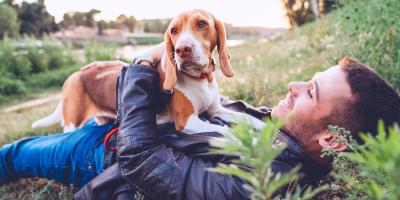
When you notice your dog losing patches of hair, your mind might jump to the worst-case scenario and begin to panic. But, don’t worry. The truth is, alopecia in dogs is fairly common and usually treatable through medication or changes in their environment. Discover what might cause dog hair loss, possible treatments and how you can keep your dog comfortable.
What Does Alopecia in Dogs Look Like?
Symptoms of alopecia in dogs can vary from dry or brittle fur to large patches of hair missing from one or more areas of the body. Look for the following symptoms that may appear suddenly or over time:
- Small, red patches of skin with no fur
- Dandruff
- Irritated skin that causes itchiness (your dog may bite or scratch at the same spot)
- Skin that appears darker with little to no fur covering it
- Excessive shedding
- Noticeable scaliness or crusty skin patches
What Causes Dog Hair Loss?
Dog hair loss, sometimes referred to as alopecia in dogs, can be frightening for owners and sometimes uncomfortable for dogs themselves. Many potential triggers may result in your dog losing patches of hair. Here are some of the most common causes of canine hair loss:
- Stress: Dogs who have an undiagnosed anxiety disorder or who are exposed to stressful conditions may pull out their fur in response to stress.
- Fleas: As annoying to humans as they are to dogs, fleas and their bites cause irritation and itchiness. It’s not uncommon for dog hair loss to be the first sign an owner has of a flea infestation.
- Mange: Caused by the mite Demodex, mange can be very uncomfortable for dogs, as it causes constant itchiness and leads to large patches of lost fur and irritated skin.
- Hormonal imbalances: Particularly as dogs get older, hormonal changes can occur that lead to hair loss. Endocrine system disorders, like hypothyroidism or Cushing’s disease, may result in your dog losing patches of hair.
- Skin infections: From ringworm to folliculitis, skin infections are a common cause of hair loss in dogs. The good news is, most skin infections can be treated easily.
- Genetics: If your dog’s mother or father was afflicted with canine alopecia, chances are your dog has the same condition.
- Allergies: Just as common in dogs as in people, allergies to the environment or ingredients in food can cause irritation and itchiness. Hair loss is a natural consequence of your dog scratching himself too much.
- Diet: Your dog’s diet may be the cause, or at least a contributor, to hair loss. Your veterinarian may recommend a change in diet to include foods to help your dog’s skin and hair.
- Change in seasons: Certain breeds are susceptible to seasonal alopecia, which is hair loss that occurs in the autumn months. This is common in bulldogs, Staffordshire bull terriers, boxers and Dobermans. It can take six months to one year for a dog’s hair to grow back.
Is Dog Hair Loss Treatable?
Unless caused by a genetic or underlying medical condition, dog hair loss is usually treatable. In addition to learning about your dog’s environment and habits, a veterinarian may take a skin sample or perform an allergy test before arriving at a diagnosis and treatment plan. Your veterinarian may recommend one or more of the following:
- Medication to treat the cause of hair loss: If fleas, a parasite or a bacterial infection are to blame for your dog’s hair loss, medication given consistently and as prescribed can alleviate the source of irritation and, over time, your dog’s hair usually returns.
- Treatment for stress: When your dog is in pain, has undergone trauma or has an anxiety disorder, the habit of nervously pulling out patches of hair can lead to discomfort and skin infections. Treating stress with medication or behavioural therapy may help alleviate stress and curb your dog’s habit of picking at their fur.
- Changes in diet, environment or bedding: Dogs who suffer from alopecia often benefit from a nutrient-rich diet that supports skin, hair and nail health. It may also be beneficial to increase the frequency with which you wash bedding or change bedding material to determine if it's contributing to hair loss.
- Adjustments to activity levels or routine: Some dogs need to be more active than others by nature. If your veterinarian recommends a change in activity level or routine, try to implement their suggestions as soon as possible.
Do I Need a Veterinarian Dermatologist?
In cases where your veterinarian cannot determine the cause of your dog’s hair loss, you may need to see a specialist for additional evaluation and testing. Veterinarian dermatologists have a wealth of knowledge about skin conditions that affect animals and, through testing, may be able to determine the exact cause of your dog’s hair loss.
What Do I Do if Treatment Doesn’t Help?
If treatment doesn’t help, let your veterinarian know right away. Because dogs can’t communicate when they’re feeling unwell, there may be a trial and error period before you find a treatment that works. Don’t lose hope. Your veterinarian is the best resource for alternate treatment methods and may suggest changes to your dog’s environment that can provide enhanced results.
The Bottom Line: Don't Panic
Though noticing your dog losing patches of hair may be frightening, it's important not to panic. Always conduct a visual inspection of the affected area and write down any recent changes in habits, diet or activities so that you may discuss this information with your veterinarian.
Related articles



